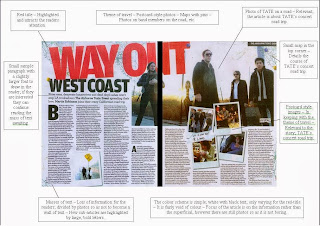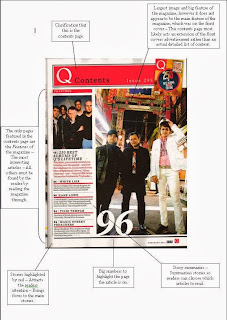With the data I gathered from my SurveyMonkey music magazine survey I have assertained a lot of useful information to aid in the development of my magazine.
Foremost, my survey yielded a gender ratio of 78% male to 22% female; admittedly more girls than I expected but I have no objections. The addition of girls in the target demographic only increases my potential magazine content.
My main age demographic is from 14 to 29 years of age. A near-exclusively young target audience gives me free reign to create content I would like to see myself, as a member of the age 14-29 electronic fanbase.
Friday, 25 October 2013
Tuesday, 22 October 2013
Audience Survey
I have decided on my music magazine's genre being Electronic so I devised a small survey to aid me in understanding my audience on a more personal basis.
The answers won't have any drastic effects on the magazine, but, for example, if a majority of the audience are female then the final product will be aimed towards girls; or women, depending on the aggrigate age.
The third question is to find out the specific sub-genre of electronic, or any hybrid genres, the potential readers will be interested in so as I can include them in the content of the magazine.
The fourth question, "who is your favourite artist?", is included to scout what artists I should implement in the magazine's main features that the potential readers would be willing to purchase.
The answers won't have any drastic effects on the magazine, but, for example, if a majority of the audience are female then the final product will be aimed towards girls; or women, depending on the aggrigate age.
The third question is to find out the specific sub-genre of electronic, or any hybrid genres, the potential readers will be interested in so as I can include them in the content of the magazine.
The fourth question, "who is your favourite artist?", is included to scout what artists I should implement in the magazine's main features that the potential readers would be willing to purchase.
Thursday, 17 October 2013
Electronic Music Audience Mood Board
I have chosen to focus on electronic music for my music magazine project. To understand my music demographic better I did some research on the internet and created a mood board to help develop my magazine for my audience.
A recurring feature of the images I found was the colour scheme; dark backgrounds with bright or luminous features such as objects or people. Another inherant feature of electronic music is ultramodern style and fashion such as the glasses, the cryptic glyphs that represent the bands, and the science-fiction-esque technology in the top-left corner.
Many of the photos I collected portray the audience of electronic music raving and partying as they like to do. Electronic music fans enjoy partying and raving and moshing at live concerts as much as, if not more than any other genre fans.
The electronic music culture is a dedicated and devoted community, so a electronic music specific magazine seems contextually and economically viable.
Monday, 14 October 2013
Music Magazine Focus Group
Music Magazine Focus Group
I created and interviewed a focus group of Year 13 students to attain information on their taste in music, and to help develop my own magazine.
In response to the question “Should a magazine be targeted to a certain genre?” the consensus was yes. If could focus on a small group of genres, but if it engaged too many it would have to either “too vague or as big as a book”. This response helped me decide that my music magazine will focus primarily on electronic, dubstep, rock, and country music; omitting metal, pop, classical, punk, and other such genres. Admittedly an odd combination that I plan to package as “new wave” or “chill” or something along the lines of a style rather than genre.
When asked; “ What is your favourite genre of music?” there were a wide variety of answers, from reggae to indie. Very little mention of the genres I myself prefer and plan to write about, but it was clear from their responses that they wanted at least a small variety, not a genre-specific magazine. This helped me to decide not to limit my genres but combine them in a new style, which is still a work in progress. Also, realising that many genres that will not feature were brought up in the discussion gave me the idea of a remix feature of the magazine; The remix feature will have remixes of songs from other genres so as not to isolate the magazine from other sects of the music industry.
Finally, when asked “Who is your favourite music artist?” the most talented and popular of their respective genres were all mentioned; Bob Marley for Reggae, Arctic Monkeys for Rock, The 1975 for Indie, Skrillex for dubstep, etc. These answers helped me realise that my magazine should feature the famous of my chosen genres as well as the talented, the up-and-coming and so forth in order to appeal to the right people and introduce them to similar music.
Tuesday, 8 October 2013
Audiences
Definition: An individual or group of people who read or consume any media text.
Why are audiences important?
Without audiences there would be no media.
Media organizations produce media texts to make profit – no audience = no profit.
The mass media is becoming more competitive than ever to attract more and more audiences in different ways and stay profitable.
Impact of new technology on audiences
Old media (TV, print, radio) which used to have high audience numbers must now work harder to maintain audience numbers.
Digital technology has also led to an increasing uncertainty over how we define an audience, with the general agreement that a large group of people reading the same thing at the same time is outdated and that audiences are now “fragmented”.
Fragmented Audience
The division of audiences into smaller groups due to the variety of media outlets.
The aim is to hit as many people as possible/sell more copies/generate a larger audience. But measuring that audience becomes difficult. You may have some people that only look online, some that only read the hard copy, or some that do both.
Types of audience
Mass audience – Media and communication that targets a very large group of people.
Niche audience – A small, select group of people with a very unique interest.
Psychographics
Every advertiser wants to target a particular type of audience. Therefore, media companies produce texts that target a particular “type” of audience.
In terms of commercial media, much of their funding is generated by advertising revenue. Their product needs to appeal to a specific type of audience so that advertisers will pay.
Group A – Doctors, Lawyer, Scientists, well paid professionals
Group B – Teachers, Middle management, fairly well paid professionals
Group C1 – Jr management, bank clerks, nurses, “white collar” professionals
Group C2 – Electricians, Plumbers, Carpenters, “Blue Collar” professionals
Group D – Manual workers, Drivers, Post sorters
Group E – Students, Unemployed, Pensioners
How do we measure audience sizes?
Sales, subscriptions, ratings, figures
Research a similar magazine and found out it’s audience size, subscription too, etc.
Age, Gender, Education, Profession, Interests and Hobbies, Fashion, Music Taste, Style, Social Media – Create a mood board of target audience.
Monday, 7 October 2013
Subscribe to:
Comments (Atom)











